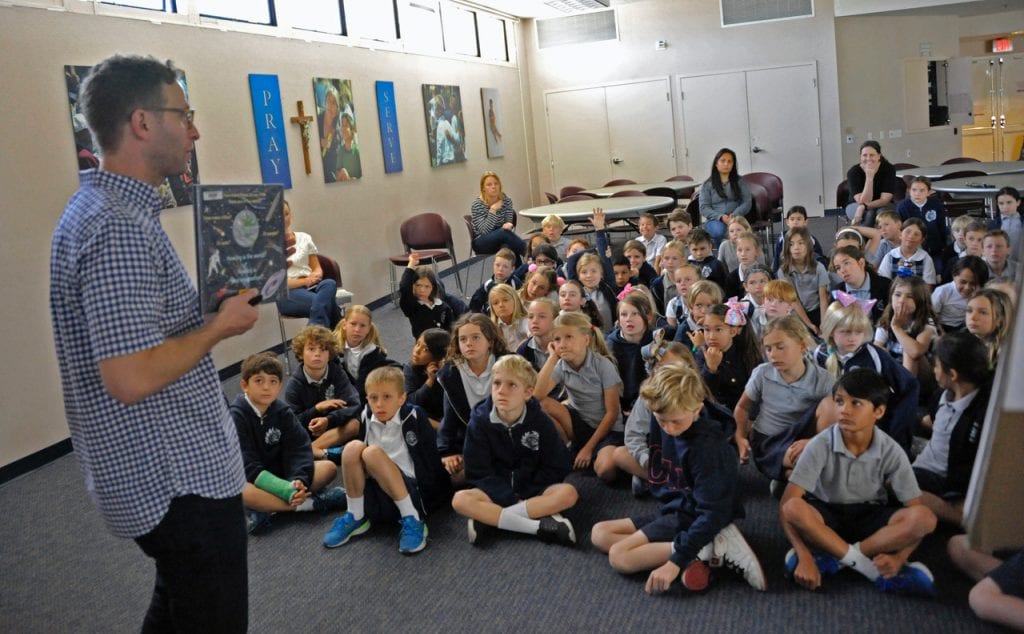
Seth Fishman talks to students from American Martyrs in Manhattan Beach about the math and science concepts in his book, “A Hundred Billion Trillion Stars.” PHOTO COURTESY SETH FISHMAN
You’ve been there – stuck in rush-hour traffic, your teeth clenching, your fingers gripping the wheel – while your precious little one pings you with a million questions from the car seat.
“Mommy, why is the sky blue? How many stars are there in the whole wide world? How many people? How many suns? How many cars?”
Disgusted with my terse “I-don’t-know” answers once, my son expelled an exaggerated sigh and proclaimed, “Man! My parents don’t know anything!”
We want our children to be thirsty for knowledge but, luckily, we don’t have to have all the answers for our mini brainiacs. The goal, according to YA literary agent and author Seth Fishman, is to cultivate and enjoy a culture of hypothesis, research and extrapolation with our kids.
Fishman’s latest book, “A Hundred Billion Trillion Stars,” is a children’s book, a fun and gorgeous trove filled with answers to questions your kids didn’t even know they wanted to ask. With illustrations by Isabel Greenberg, the book takes young minds to outer space and to the other side of the world and back, using a string of big (estimated) numbers as its vehicle. It has been lauded by math teachers and critics and garnered the 2018 Mathical Award.
Your book is a fun math and science lesson. Do you have a background in these subjects?
I majored in history and creative writing. My father was a scientist, a geologist, and I always cared about science and math, but didn’t take it to the next level. Perhaps I wasn’t good enough to take it to the next level, but I was good enough to enjoy it. When I was a student at Princeton, I took an astronomy class and Neil deGrasse Tyson taught one-third of the class. [He has] this ability to connect to a student mainly through comparisons. It’s all about grasping the idea of sizes.
When did you decide to write “A Hundred Billion Trillion Stars,” and what was the process like?
I remember after my son Weston was born, there was a moment when I was thinking about questions he would ask. “How many stars are in the sky?” – things like that. I had the inspiration for the book sort of in hand. I represent a big number of science comics. [Cartoonist and scientific theorist] Randall Munroe helped me with the fact-checking. He is a genius.
I wrote the draft pretty quickly. I knew that I wanted to go from far out all the way zoomed in to the child individually. Even though they are one of many, they are also a very unique one. I’ve written two YA books, but I just really enjoyed writing this picture book. I didn’t set out saying “I’m going to teach kids math,” so it feels cool hearing from math and science teachers.
What age group is the book meant for?
I do school visits in the area, and I’m able to do similar but different presentations for younger and older kids. Older kids are able to get the math a lot better and able to respond to joking and are more playful with the concepts. Younger kids are still able to be wowed by the numbers, even if they can only count to 20. Parents and teachers don’t understand 100 billion trillion, either. It’s a great unifier. No one knows.
How should parents use the book at home?
There is a narrative path in this book that allows kids to relate to the voice and brings them through the educational process. You can measure things around the house. HarperCollins did a teacher’s guide that’s online and is downloadable.
When I do presentations at school, I start off with the number 100 billion trillion to see if students can recognize it. Once they see it on the board, they can compare it to other numbers. “How many fingers do we have in this room?” I ask. We read the book, and I stop and explain. The real number that’s useful is that if you went outside at night, you could only count 5,000 stars. Numbers can get really big. I bring a jar of pennies for them to guess.
You talk about educated guesses in your author’s note. There is one number – in the course of a lifetime we’ll eat “70 pounds of bugs…”
It’s from the lettuce you eat. The math that you play with in that kind of game is you figure out how much is on something, then estimate how much of that will you eat over the course of a lifetime. I found the facts. A number of people have written articles on this fact. I would literally sit there and think, “What’s a cool thing a kid would want to know?”
I’ve been just delighted and surprised by the reception. It’s been more than I could have dreamed.
For more on Fishman, visit sethasfishman.com.


























